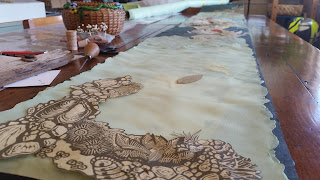 |
| Lost Landscape Meander Books by Toni Hartill |
Artist's Statement:
Imagined Journeys
through Lost Landscapes I, II, III
Imaginary journeys through the lost landscapes that once
were the swamps of the Hauraki Plains. It is estimated that more than 98% of
pre-European Kahikatea has been lost nationwide and now only occurs as forest
fragments. Since researching our nation’s history regarding the demise of our
pre-European landscapes I feel bereft for all we have lost and I fear for what
we continue to lose.
 |
| Lost Landscape Meander Books by Toni Hartill |
The making of the books
These books came about through play.
And through a desire to paint rather than print.
You may know that I was primarily a painter that has got way-laid by the lure of printmaking and I often, and always, long to paint again. These wee books were joyous to create: playing with paint, zoning out in the moment with wet-in-wet, colour and composition...
The structure of the books is known by various names including Snake Book, Meander Book, Accordion Book... My preference in this case is the Meander book as it suits the idea of a journey quite aptly.
They began with very loose watercolour paintings on both sides of heavy watercolour paper. I very much had ideas of imagery in my head (my imagined landscapes) and an idea of how the large sheet would actually read as many smaller pages within the books.
The boxes are made using a simple origami pattern folded into a box with a matching fitted lid.
The paper for the boxes is antiqued and printed with text from an article, written by a descendant of
the Bagnall brothers who ran a mill on the banks of the Waihou River at Turua,
Hauraki Plains. There they milled Kahikatea trees to be made into butter boxes.
The descendant expresses regret for their family’s part in the destruction of
the forest as they describe the “men with axe and saw, slashing their way into
the doomed bush… It was the beginning of the end for many of the feathered
world that inhabited its depths… The massive trunks came faster and faster… but
a grand and noble forest lay dying.”
Le Baigneau, “Where the Village Slew the Forest”, NZ Herald, 24
April 1937.
Refer also to:
Watercolour paintings
The finished painted surfaces
Gridding up and cutting
The joy of 3D forms
Turning the pages to discover the mini landscapes within
Imagined Journeys
through Lost Landscapes I, II, III
Watercolour accordion books within origami boxes
Unique
by Toni Hartill
Small x2: 60 x 60 x 30mm I, II
These books are exhibited, as part of a larger body of work
inspired by the loss of the Kahikatea forests of NZ,
in the Forest has the Blues - Murmurings exhibition
at the Steel Gallery, Franklin Arts Centre, Pukekohe.
Opens Saturday 20th July, 10.30am.
Artist talk: 11.15am.
Exhibition: 20 July - 24 August, 2019.
View other books in my Artist Books tab.
Follow me on Instagram
for a more regular insight into my work
or visit me on facebook:
Thanks for visiting!














































































